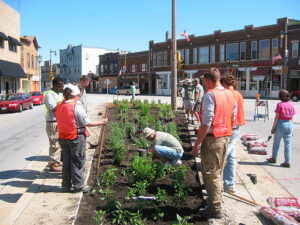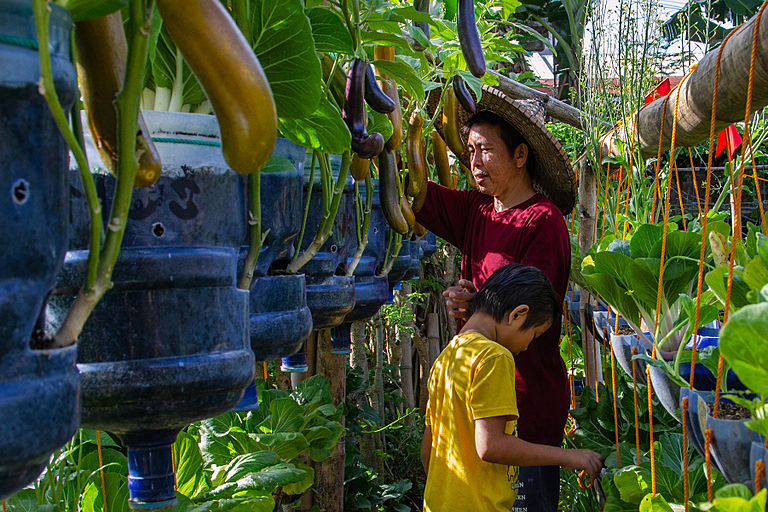Meaningful Participation in Urban Ecosystem-based Adaptation – How Can it Work?

by Rachel Nisbet (International Rainwater Harvesting Alliance (IRHA)), Heidi Tuhkanen (Stockholm Environment Institute (SEI)), Alannah Hofemeier (PlanAdapt)
Ecosystem-based adaptation (EbA) describes methods of ‘working with nature’ to produce goods and services that reduce human and ecosystem vulnerability to climate change. For a project to qualify as EbA, it should advance climate justice, by supporting ‘equitable governance’ and enhancing ‘capacities’ (FEBA, 2017). In a context of Urban EbA, the social principle, ‘participation and inclusiveness’, helps to ensure that EbA is equitable. This is one of 7 social principles, identified to advance climate justice; the remaining 6 are: capacity building, fairness and equitability, gender consideration, livelihood improvement, appropriateness of scale and integration of intergenerational knowledge (Vidal Merino et al., 2021).
For a project to meet the social principle of participation, it should ‘be designed, developed and implemented involving local stakeholders, particularly historically marginalised groups, via participatory methods. Actively engaging cross-disciplinary stakeholders aims to ensure transparent, accountable, culturally appropriate and equitable outcomes’ (ibid.).
Which approaches foster participation?
Participation can be designed into projects using motivational approaches, including:
-
Financial Incentives In the Páramos Conservation Corridor Project, implemented by Conservation International in Bogotá, Colombia, community theatre was used to build trust with local, homeless stakeholders, and engage them in this creek restoration initiative. They could earn money by supporting activities run by this theatre. Additionally, ten young local people that were not part of the homeless community became involved in eco-tourism activities; for instance, the creation of trails along restored creeks.
-
Altruistic Motivation The Green Seattle Partnership (GSP), a governmental collaboration with 54 volunteer-based partner organizations, aims to engage diverse stakeholders in restoring the city’s urban forests. Launched in 2005, this stewardship programme initially relied on a ‘save the trees’ rhetoric, which principally appealed to well-off, white, urban stakeholders, who acted to preserve nature’s intrinsic value. However, its updated strategic plan ensures that paid opportunities are allocated for minority and under-represented groups so these demographics see themselves as present within the partnership, and it offers training days on institutional racism. These changes are important to increase the racial and ethnic diversity of volunteers and Forest Stewards involved in the GSP. This is one way for this demographic to discover the benefits associated with this programme, including the reduction in urban heat islands, and increased urban biodiversity. However, this is part of a recognitional justice agenda to acknowledge systemic, social injustices associated with what this blog post describes as ‘historical and contemporary legacies of racism in Seattle’s Green spaces’.
- Self-Help for Mental Well-being In the Kayole Estate Transformation Project, 60-70 youth volunteers are active in creating green spaces for recreation. This community-based project is motivated by local people’s desire to have a natural space to unwind and relax after working in Nairobi city. ’.
- Material Recompense In the Rain Forests People project, co-implemented by the International Rainwater Harvesting Alliance and APAF-Senegal, village members in the rural communes of Loul Sessène and Djilasse were involved in participatory mapping as a first phase of EbA implementation. The financial benefits of agroforestry and rainwater harvesting were demonstrated to these communities, with 70 farming families enjoying improved, domestic water supply and drinking water quality and increased farming yields. As part of this initiative, the wider community to consider links between recent industrial farming practices, environmental degradation, agricultural sovereignty, and health. While this EbA project was based in a rural, rather than an urban area, this process of developing community engagement with EbA, based on its demonstrated social benefits for a first pilot group deserves more extensive implementation.

How is participation discussed at the Nature of Cities Festival?
At the Nature of Cities Festival 2022, in a session discussing Urban EbA, attendees were invited to discuss the principle of participation and inclusiveness. The question – what constitutes meaningful participation? – shaped the conversation. Exchanges on how a truly participatory process can be fostered, foregrounded how capacity needs to be allocated. This is particularly the case where EbA functions as adaptation for sustainable development. The following points were observed regarding long-term processes of participation:
- Funding is necessary to allocate time and resources for local NGOs and local authorities to build trust and meaningful collaborative practices with local community members.
- This can involve including local communities in project design, using processes of participatory mapping.
- Resources are also necessary to enable participants to communicate with each other and with local NGOs during the project implementation phase.
The fraught question of how to design participatory processes that avoid reinforcing pre-existing structural inequalities was raised in group discussion. A collaborative, participatory process for Urban EbA that furthers racial equity by empowering the voice of minorities and drawing attention to systemic privilege was identified as one means for addressing this problematic. Angeulovski et al. (2020) propose a framework for responding in this context. It’s worth noting, however, that any such participatory process needs to respect participants’ time commitments, regarding their professional and domestic obligations and the burdens caused by social injustices in general. Clearly signposting how participants can benefit from engaging with EbA and identifying what specific adaption outcomes are desired by diverse community-members, then, remains a key point of focus in any Urban EbA participatory process that furthers climate justice.
Further information regarding the seven social principles for Urban EbA can be found in the technical paper published jointly by Plan Adapt and FEBA: Climate Justice for People and Nature through Urban Ecosystem-based Adaptation (EbA): A Focus on the Global South
